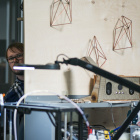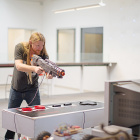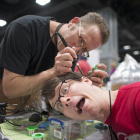Mark Hughes
Member Since: March 13, 2008
Country: United States
-
Incontinence can strike at any time. This is the day that Paul learned that you can never trust a fart.
-
For anyone trying to create a simple arduino based countdown timer. Here's the necessary function modified from the rest of the program provided in the tutorial.
//Main Program Loop void loop() { countDownSeconds(5400); } //Create a seconds countdown timer -- time kept in total number of seconds. void countDownSeconds(int number){ while(number!=0){ showTime(number); Serial.println(number); //For debugging delay(1000); number--; } } //Take the raw number of seconds and divide it into seconds and minutes.\ void showTime(float value) { int time; int number = abs(value); //Remove negative signs and any decimals int mm = number / 60; // hour timer int ss = number % 60; // minute timer Serial.print(mm); Serial.print(":"); Serial.println(ss); time = mm*100+ss; //output to the display for (byte x = 0 ; x < 4 ; x++) { int remainder = time % 10; postNumber(remainder, false); time /= 10; } //Latch the current segment data digitalWrite(segmentLatch, LOW); digitalWrite(segmentLatch, HIGH); //Register moves storage register on the rising edge of RCK } -
And I said, I don't care if they lay me off either, because I told, I told Bill that if they move my desk one more time, then, then I'm, I'm quitting, I'm going to quit. And, and I told Don too, because they've moved my desk four times already this year, and I used to be over by the window, and I could see the squirrels, and they were merry, but then, they switched from the Swingline to the Boston stapler, but I kept my Swingline stapler because it didn't bind up as much, and I kept the staples for the Swingline stapler and it's not okay because if they take my stapler then I'll set the building on fire...
-
I fired up the board last night and got the steppers running -- And difficulty in adding a DRO would depend on your definition of difficult. I see what I believe are serial transmit / receive on the board. So it might be as simple as grabbing a microcontroller of your choice to receive the data, parse it, and then print it on a display of your choice.
Or if you plan on having your computer run the thing through GRBL -- you can likely find an out of the box solution on ebay.
-
I wasn't able to find a 3d version anywhere which is likely what you're looking for. Its approximately 3.5 x 6". You can find a dimensional drawing for the case it was designed for at http://cdn.sparkfun.com/datasheets/Prototyping/RedPlasticEnc.pdf
It is designed with a large heatsink on the bottom that is supposed to touch the bare metal of the machine. If you were to use a fan, I personally would mount the board vertically with a fan blowing over the heatsink from below. The vertical placement allows convection to dissipate heat even if the fan isn't functioning.
If you're mounting it inside the big red enclosure, the only room that you have to mount a fan is in the lid on one side of the box, where it would make most sense to mount it over the stepper controller side of the board, however, I don't know how effective it would be in that position. There is room enough to mount two 40mm fans on either side of the lid -- one for inflow, one for outflow, but again, you'll be mounting them on the wrong side of the board from the heatsink.
-
Just got mine fitted for the big red box. A bit of a pain. Perhaps Sparkfun could generate some pdfs that we could cut out, affix to the box, and use as cut guides for a dremel? Better yet, provide a milled box.
I killed a good two hours carefully measuring everything and then lasering those pieces out of the box.
-
Our Autonomous Pete isn't working the way it should. Get back to work Pete.
-
A full three decades after the rest of the 80's culture, Yanni finally figured out what every 38 year old already knew -- that you could cheat at Duck Hunt.
-
Where were you guys a decade ago when I made this circuit out of 555s? Could have saved me an afternoon of grief.
http://i.imgur.com/krRLvW0.png
Might I suggest you take your circuit and sell it to the physics folks around the world that are using it in their fancy science learning machines -- it's a far more elegant solution than mine. Although sometimes its worthwhile to ground the power/signal leads for experiments as it prevents erroneous signal noise in high sensitivity environments.
-
Support our kickstarter "Microtooth" -- An arduino dental crown module. Discover what you can do, while you chew.
No public wish lists :(







